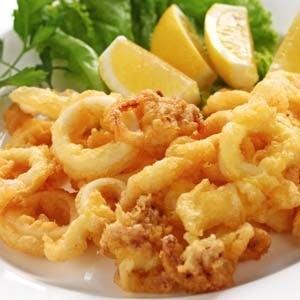
Well, now there’s another reason to enjoy the bounty the sea has to offer.
Squid is not only a sustainable source of seafood; research shows that, when prepared in the right way, it’s a pretty good source of omega-3 fatty acids. A 100g serving of squid can contain up to 0.6g of omega-3 fatty acids out of the recommended 7 to 11g you should be consuming each week.
And here’s why you really should be paying attention: omega-3 fatty acids can help lower your risk for heart disease, cancer and rheumatoid arthritis. Plus, preliminary research shows that these essential fatty acids can keep your memory sharp and improve your mood.
Apart from upping your omega-3 levels, squid offers other health benefits too: 85g contains 80 calories and 13g of protein. It also provides 20% of the recommended daily allowance (RDA) for vitamin B2, phosphorus and vitamin B12, and contains vitamin B6, magnesium, zinc, vitamin C, vitamin B3, calcium and iron.
Other good marine sources of omega-3 include pilchards, sardines, salmon, snoek, tuna, herring and galjoen.
How much you need
Recommendations for omega-3 fatty acid intake vary between a daily intake of 400mg and 1,000mg of EPA and DHA, two types of omega-3 fatty acids.
To obtain this suggested amount of omega-3 just through food can be quite a challenge. The first step is to start eating two to three servings of oily fish per week.
Although it’s harder to reach your weekly omega-3 goal if you don’t eat fish, you can increase your intake significantly through omega-3-enriched foods and drinks, such as milk, yoghurt, eggs, bread and soy drinks. However, it’s a good idea to discuss the use of a supplement with your doctor, dietician or pharmacist.
Look out for good-quality fish-oil capsules that contain at least 500mg of EPA and DHA in a daily dose to supplement your diet. When you’re out shopping for omega-3 enriched foods and drinks, always go for the ones clearly marked “with added omega-3 fatty acids”.
For the calamari clan
Calamari is another, possibly surprising way of getting your weekly dose of omega-3 fatty acids.
Instead of waiting for your once-a-month restaurant visit to eat your fill of calamari, try cooking it yourself. It’s easier than you think.
When preparing squid, remember that it’s best cooked over high heat for a very short time. Also keep in mind that deep-fried calamari contains a lot of added fat – grilled or seared calamari should always be your first choice.
Easy calamari recipe
Ingredients
450g calamari tubes or strips, cleaned
4 garlic cloves, minced
½ tsp lemon rind, grated
3 tbsp lemon juice
¼ cup Canola oil
2 tbsp fresh oregano, chopped
½ tsp salt
½ tsp pepper
Lemon wedges
Method
- In a large bowl, whisk together the garlic, lemon rind, lemon juice, olive oil, oregano, salt and pepper.
- Cut calamari tentacles from tubes.
- Score the top layer of each tube crosswise, 5cm apart.
- Add the tentacles and tubes to the mixture in the bowl, and toss to coat.
- Cover, and refrigerate for 30 minutes.
- Place on a greased grill over high heat, close lid and cook for two minutes, turning once.
Serve on a bed of fresh mixed greens and drizzle with a squeeze of lemon.
REMEMBER: Squid is an environmentally friendly source of omega-3 fats and is not overfished. So, you can eat your lion’s share without feeling guilty about the impact on the environment. Enjoy!




 Publications
Publications
 Partners
Partners














